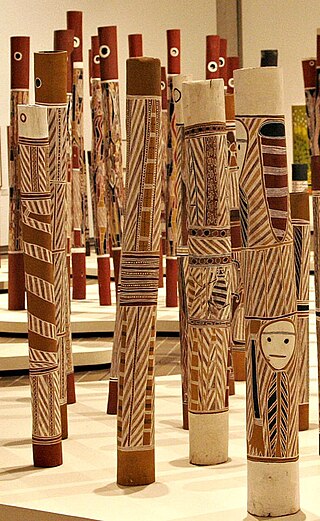
Arnhem is a city and municipality situated in the eastern part of the Netherlands, near the German border. It is the capital of the province of Gelderland, located on both banks of the rivers Nederrijn and Sint-Jansbeek, which was the source of the city's development.
The Djang'kawu, also spelt Djanggawul or Djan'kawu, are creation ancestors in the mythology of the Yolngu people of Arnhem Land in the Northern Territory of Australia. It is one of the most important stories in Aboriginal Australian mythology, and concerns the moiety known as Dhuwa.

Indigenous Australian art includes art made by Aboriginal Australians and Torres Strait Islanders, including collaborations with others. It includes works in a wide range of media including painting on leaves, bark painting, wood carving, rock carving, watercolour painting, sculpting, ceremonial clothing and sandpainting; art by Indigenous Australians that pre-dates European colonisation by thousands of years, up to the present day.

Arnhem Land is a historical region of the Northern Territory of Australia. It is located in the north-eastern corner of the territory and is around 500 km (310 mi) from the territorial capital, Darwin. In 1623, Dutch East India Company captain Willem Joosten van Colster sailed into the Gulf of Carpentaria and Cape Arnhem is named after his ship, the Arnhem, which itself was named after the city of Arnhem in the Netherlands.
Maningrida is an Aboriginal community in the heart of the Arnhem Land region of Australia's Northern Territory. Maningrida is 500 km (311 mi) east of Darwin, and 300 km (186 mi) north east of Jabiru. It is on the North Central Arnhem Land coast of the Arafura Sea, on the estuary of the Liverpool River.

Oosterbeek is a village in the eastern part of Netherlands. It is located in the municipality of Renkum in the province of Gelderland, about 5 km (3.1 mi) west of Arnhem.

Yirrkala is a small community in East Arnhem Region, Northern Territory, Australia, 18 kilometres (11 mi) southeast of the large mining town of Nhulunbuy, on the Gove Peninsula in Arnhem Land.

John Mawurndjul is a highly regarded Australian contemporary Indigenous artist. He uses traditional motifs in innovative ways to express spiritual and cultural values, He is especially known for his distinctive and innovative creations based on the traditional cross-hatching style of bark painting technique known as rarrk.

Gunbalanya is an Aboriginal Australian town in west Arnhem Land in the Northern Territory of Australia, about 300 kilometres (190 mi) east of Darwin. The main language spoken in the community is Kunwinjku. At the 2021 Australian census, Gunbalanya had a population of 1,177.

Milingimbi Island, also Yurruwi, is the largest island of the Crocodile Islands group off the coast of Arnhem Land, Northern Territory, Australia.
The National Aboriginal & Torres Strait Islander Art Award (NATSIAA) is Australia's longest running Indigenous art award. Established in 1984 as the National Aboriginal Art Award by the Museum and Art Gallery of the Northern Territory in Darwin, the annual award is commonly referred to as the Telstra National Aboriginal & Torres Strait Islander Art Award, the Telstra Award or Telstra Prize. It is open to all Aboriginal and Torres Strait Islander artists working in all media.
The American-Australian Scientific Expedition to Arnhem Land remains one of the most significant, most ambitious and least understood expeditions. Commenced in February 1948, it was one of the largest scientific expeditions to have taken place in Australia and was conducted by a team of Australian and American researchers and support staff.
George Jiří Chaloupka OAM, FAHA was an expert on Indigenous Australian rock art. He identified and documented thousands of rock art sites, and was a passionate advocate for Aboriginal Australian art, as longest continuing art tradition in the world. He is especially known for the much-debated assignation of a four-phase style sequence to rock art in Arnhem Land, and the term "Dynamic Figures", which he assigned to rock art described by him in Mirrar country of western Arnhem Land.
Mungurrawuy Yunupingu (c.1905–1979) was a prominent Aboriginal Australian artist and leader of the Gumatj clan of the Yolngu people of northeastern Arnhem Land in the Northern Territory of Australia. He was known for his bark paintings.
Mawalan Marika (c.1908–1967), often referred to as Mawalan 1 Marika to distinguish from Mawalan 2 Marika, was an Aboriginal Australian artist and the leader of the Rirratjingu clan of the Yolngu people of north-east Arnhem Land, in the Northern Territory of Australia. He is known for his bark paintings, carvings and political activism.

Wukun Wanambi was an Australian Yolngu painter, filmmaker and curator of the Marrakulu clan of northeastern Arnhem Land, Northern Territory.

The Standard Bearer is a three-quarter-length self-portrait by Rembrandt formerly in the Paris collection of Elie de Rothschild, and purchased by the Rijksmuseum for 175 million euros with assistance from the Dutch state and Vereniging Rembrandt in 2021. It was painted on the occasion of the artist's move from Leiden to Amsterdam and is seen as an important early work that "shows Rembrandt's ambition to paint a group portrait for the Amsterdam militia, at the time the most valued commission a painter could be awarded."
Howard Morphy is a British anthropologist who has conducted extensive fieldwork in northern Australia, mainly among the Yolngu people. He was founding director of the Research School of Humanities and the Arts at the Australian National University and is currently a distinguished professor of anthropology.

A memorial pole, also known as hollow log coffin, burial pole, lorrkkon, ḻarrakitj, or ḏupun, is a hollow tree trunk decorated with elaborate designs, made by the Yolngu and Bininj peoples of Arnhem Land in the Northern Territory of Australia. Originally used to hold the bones of deceased people or for burial ceremonies, they are now made as works of art. The permanent exhibit at the National Gallery of Australia, Aboriginal Memorial, consists of 200 hollow log coffins, created by 43 artists.
Liesbeth Brandt Corstius was a Dutch art historian, feminist and museum director.












